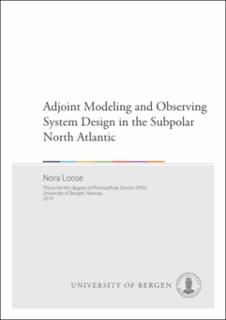| dc.description.abstract | The near-surface ocean currents of the subpolar North Atlantic transport large amounts of heat from the subtropics to higher latitudes, affecting Arctic sea ice extent, the melting of the Greenland Ice Sheet, and the climate in western Europe and North America. Moreover, deep water formation in the subpolar North Atlantic actively shapes the Atlantic meridional overturning circulation, which connects the surface with the deep ocean and the northern with the southern hemisphere. The recently acquired data from the OSNAP (Overturning in the Subpolar North Atlantic Program) mooring array challenges our understanding of the processes that govern circulation and deep water formation in the subpolar North Atlantic. However, only long-term and sustained ocean observations can provide the much-needed benchmark to evaluate climate model simulations, to advance our understanding of key mechanisms, and to predict the role of the North Atlantic in future climate changes and anthropogenic carbon uptake. Unfortunately, most observational efforts rely on short-term funding periods. Given the cost of deploying and maintaining ocean observing systems, these systems have to be designed carefully. Key questions are: What information is contained in already existing observation networks? What do existing networks, such as the OSNAP array, tell us about hydrographic and circulation quantities in remote oceanic regions with few observations? In this thesis, a novel approach to ocean observing system design is explored that is able to address these questions. The approach makes use of adjoint modeling and Hessian-based Uncertainty Quantification (UQ) within a global oceanographic inverse problem.
Adjoint-derived sensitivities reveal that the eastern boundary of the North Atlantic and the coasts of Iceland and Greenland are important pathways for communicating wind-driven pressure anomalies around the entire subpolar North Atlantic and the Nordic Seas. Consequently, the OSNAP observing array shares many dynamical pathways and mechanisms with oceanic quantities that are remote from the array. The OSNAP array has therefore potential to inform these unobserved - or unobservable - quantities: for instance, ocean heat content in the Nordic Seas or close to Greenland’s margins. In this thesis, this potential is quantified within the state-of-the-art ECCO (Estimating the Circulation and Climate of the Ocean) state estimation framework, by combining physical relationships in the model with prior information and data uncertainties.
The effectiveness of an observing system is determined by how well it captures climate-relevant signals and important dynamical adjustment mechanisms. A second important factor, however, is how strongly the monitored signals are masked by noise. All factors combined, heat transport measurements across the OSNAP-West transect, extending from Labrador to South Greenland, impose an overall much stronger constraint on the ECCO state estimate than heat transport measurements across the OSNAP-East transect, extending from South Greenland to Scotland. This is largely explained by the fact that climate signals detected by OSNAP-West are less noisy compared to climate signals detected by OSNAP-East. As a result, transport and hydrographic quantities - even in the Nordic Seas - are constrained more efficiently by OSNAP-West than OSNAP-East observations, contrary to recent findings. This suggests that OSNAP-West is important for informing remote climate signals.
This thesis explores the physical mechanisms that link the subpolar North Atlantic and the Nordic Seas, translates the mathematical concepts that underlie Hessian-based UQ to dynamical concepts, and discusses benefits, shortcomings, and future challenges for designing an effective, long-term Atlantic observing system by means of UQ within ocean state estimation. | eng |
